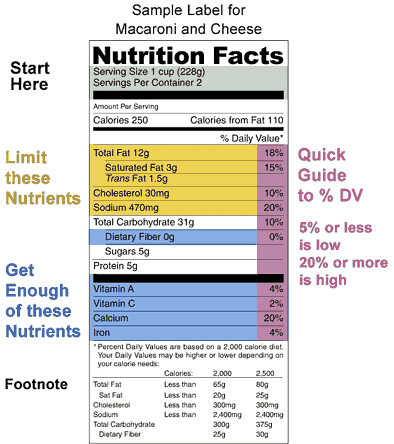 Many people haven't the slightest idea how to read a nutritional label—ya know, that thing on the side of the box that lists 'servings', 'serving size', 'fat', etc? Well, that little box is your best supermarket friend because it gives you the facts about the item you're purchasing.
Many people haven't the slightest idea how to read a nutritional label—ya know, that thing on the side of the box that lists 'servings', 'serving size', 'fat', etc? Well, that little box is your best supermarket friend because it gives you the facts about the item you're purchasing.When making a decision to buy any item you haven't grown or raised yourself, it's important to take note of what exactly has gone into producing it and how said production makes that particular item good or bad for your overall health.
I typically examine three basic elements when reading a nutritional label:
- Dietary Fiber (per serving): Fiber is your friend. I won't go into the medical benefits (find a great article about that here) of what it can do for you but, I can tell you this much, it certainly helps keep my body feeling toxin free. I tend to look for foods that offer 3 or more grams of fiber per serving, but the more the better.
- Fat content (per serving): Where fiber is your friend, bad fats (foods high in saturated and/or trans fats) are your enemy. Stay away from chips and other packaged snack items that are fried in peanut or vegetable oil. Even more, if you choose to indulge in said items, note the serving size—most potato chips are meant to be eaten 10-12 at a time. If you're eating half a bag of Lay's a day, you could be hurting yourself.
- Sodium (per serving): The recommended daily allowance (RDA) for sodium, per day, is 24-2500mg. If that sounds like a lot, it's not, that's about a teaspoon per day. If frozen dinners are a staple in your daily diet, there's a good chance you are well over that allowance after eating just one meal. Pay attention to this element the most as it's the easiest to go overboard on and the hardest to track.
Too much sugar can put you on a fast track towards diabetes, bad carbohydrates (particularly the ones you glean through consumption of white rice, soda, and white bread) can lead to heart disease and weight gain, and too many calories will topple any healthy living plan. Try to keep your caloric intake reasonable and make sure that the majority of that intake comes from fresh, not processed, foods.
It's my way of telling my body 'thank you' for not breaking down on me in a pinch.
Good fuel typically results in good mileage where the body is concerned. Fill yours up with as much good stuff as possible and you'll be surprised at the difference it makes.

No comments:
Post a Comment